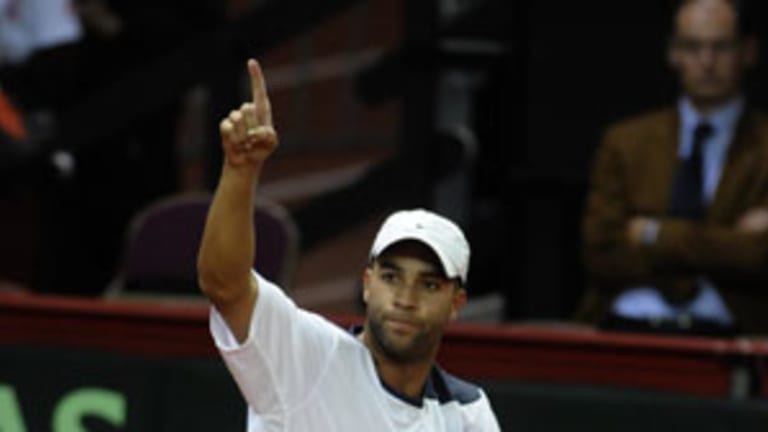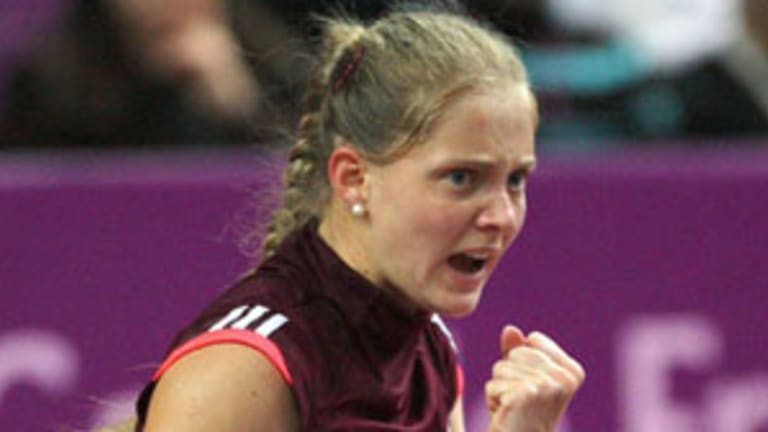Does anyone have a quick cure for a pulled hamstring? I’ve been sidelined with one for three weeks now and am starting to go a little stir crazy without any racquet sports to play. At first I enjoyed doing different things, seeing more movies and art exhibits and visiting forgotten neighborhoods of New York. But now, frankly, that's starting to get old—a good squash game is worth 10 trips to MOMA. You know you’re in trouble when you spend the heart of Saturday afternoon on the couch watching a full hour of a Columbo rerun that you’ve seen at least five times.
The couch-potato lifestyle did give me a chance to catch a couple of entertaining tennis matches. The first came on Friday afternoon, when James Blake stepped onto a soft and bumpy Vienna clay court to make his customary appearance in the second singles for the U.S. Davis Cup team. You had to feel for Blake and his teammates: If they were to lose to the scrappy, lefty Austrians, they would have enjoyed their status as Davis Cup champions for exactly two months. Does anyone, even the hardest-core Cup apologist, think that makes sense, considering the travel and effort it takes to win the thing in the first place?
By the time I started watching, Blake was in a familiar spot: staked to a 1-0 lead by Andy Roddick but down a set and a break, this time to Stefan Koubek, who appeared to have a definite edge on his red-clay home court. Blake had beaten Koubek in a charged-up four-setter at the U.S. Open last fall, but this time the Austrian’s retrieving and counterpunching abilities were giving him the upper hand. I didn’t see it, but apparently James was up to old tricks in the first set. He served at 5-4 and went up 30-0, only to be broken and eventually lose 7-5.
The match looked all but over as Blake served at 2-5 and double-faulted for 30-30. There was an all-too-familiar look of hopelessness in his eye, usually a harbinger of doom for Blake. But this time it didn’t last long. He held, broke, and then gritted out a tough hold at 4-5. This was a competitor I didn’t recognize. Blake slowed down before important points; stared across the net with restrained menace after hitting a big shot; and served his best when he needed it most, on deuce and 40-30 points. This was more impressive than his final-round win in Portland over Mikhail Youzhny.
Blake went on to win the second set, and Koubek looked shellshocked after that. The Austrian ceded court position in the third, desperately scrambling to stay in points rather than counterpunching his way into control of them. Blake just got stronger, particularly on the forehand side, which he rolled crosscourt with depth and smacked for outrageous winners down the line. It was a complete turnaround, and a complete performance for the American. When he drilled another forehand winner to go up 3-0 in the third, U.S. captain Patrick McEnroe stood with a slight look of disbelief on his face. Blake came over to bump fists and PMac nodded and pursed his lips as if to say, “I’m not sure I believe what I’m seeing, but I’ll take it.”
Yes, the U.S. is on a Davis Cup roll. The Bryans were absolutely dominant the next day. Every time I looked up from the couch they had just broken serve. As one of their opponents, Julian Knowle, put it, “They outplayed us in every department of the game and we were miles away from winning.” Hey, he was just being honest. The U.S. team returns home for an intriguing quarterfinal tie April 11-13, against a Gasquet-Tsonga led French squad.

